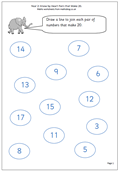 This maths worksheet for year 2 children looks at pairs of numbers which make 20. Before doing this children should be confident with, and know by heart, all pairs of numbers which make 10. Once they know these, pairs that make 20 becomes easy; just one of each pair is ten more e.g. 6 and 4: 16 and 4. Being able to work quickly with mental arithmetic is one of the keys to success in school as so much of the maths lesson today is carried out orally and children gain or lose confidence very quickly when answering in front of a whole class.
This maths worksheet for year 2 children looks at pairs of numbers which make 20. Before doing this children should be confident with, and know by heart, all pairs of numbers which make 10. Once they know these, pairs that make 20 becomes easy; just one of each pair is ten more e.g. 6 and 4: 16 and 4. Being able to work quickly with mental arithmetic is one of the keys to success in school as so much of the maths lesson today is carried out orally and children gain or lose confidence very quickly when answering in front of a whole class.
Maths Worksheet: Decimals with a total of 10
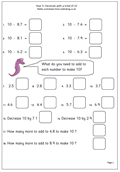 Another mental arithmetic maths worksheet on decimals, suitable for Year 5. This page looks at pairs of decimals that make 10. Once again there are several ways of tackling these questions.
Another mental arithmetic maths worksheet on decimals, suitable for Year 5. This page looks at pairs of decimals that make 10. Once again there are several ways of tackling these questions.
One way is to add on from the smaller number, firstly, the tenths to make the next whole number, and then the units to make 10.
eg 10 – 6.7
Count on from 6.7 to 7 which is 0.3
Then count on from 7 to 10 which is 3
Answer 3 + 0.3 = 3.3
Another way is to count on the units first and then the tenths, but beware the answer which counts on 4 from 6 to make 10 and than counts on 0.3 as this will result in an answer which is one too many: a common slip-up.
Another way of doing this is to ignore the decimal and think of the question as 100 – 67. Work it out mentally (which is 33) and then convert back to 3.3.
Maths Worksheet: Add 9 Mentally
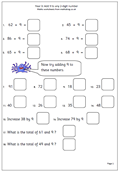 Being successful with mental arithmetic is all about having a ‘feel for numbers’ and being able to manipulate them to suit the way you like to calculate. Knowing a few basic ‘tricks’ helps enormously with this and gives children confidence.
Being successful with mental arithmetic is all about having a ‘feel for numbers’ and being able to manipulate them to suit the way you like to calculate. Knowing a few basic ‘tricks’ helps enormously with this and gives children confidence.
Adding 9 might sound a little dull, but knowing that you can do it in your head by adding ten and subtracting one can make all sorts of other mental additions easy, as we will see later adding 19, 29, 39 etc all follow the same path as do adding 18, 28, 38 etc; these tasks which at first glance might seem tricky end up being easy.
This is suited to year 3 children who are confident with adding single digits and can count up to 100.
Maths Worksheet: Counting up, crossing thousands
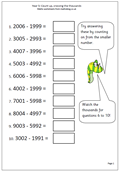 There are many occasions when a 4-digit subtraction can be done ‘in your head’. These questions, suitable for Year 5, are examples of this. They all involve numbers which are just over and just under a whole thousand.
There are many occasions when a 4-digit subtraction can be done ‘in your head’. These questions, suitable for Year 5, are examples of this. They all involve numbers which are just over and just under a whole thousand.
For example: 3003 – 2994
Probably the easiest way to do this mentally is to count on 7 from 2993 to make 3000 and then count on, or add, the extra 4, making 11.
This is much easier than doing the question on paper, with lots of ‘borrowing’ and carrying, crossing out etc!
Coming soon: Counting, addition and more decimals
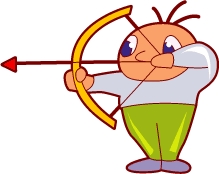 You can really hit the mark with next week’s selection of worksheets. Most will be to do with mental methods of counting and addition. Firstly, we have counting on with large numbers. Most of these questions cross the thousands boundary and also provide good practice at reading larger numbers. For Year 3 we have an addition worksheet on how to to add 9 to 2-digit numbers mentally. There will also be a page of standard written addition of 4 digit numbers in our Four Rules section.
You can really hit the mark with next week’s selection of worksheets. Most will be to do with mental methods of counting and addition. Firstly, we have counting on with large numbers. Most of these questions cross the thousands boundary and also provide good practice at reading larger numbers. For Year 3 we have an addition worksheet on how to to add 9 to 2-digit numbers mentally. There will also be a page of standard written addition of 4 digit numbers in our Four Rules section.
For older children there is a page on decimals, working out decimals with a total of ten.
If you are looking for addition worksheets, don’t forget to look in the Four Rules section as well as in each individual year under Knowing Number Facts and Calculating.
Maths worksheet: Add decimals mentally (1)
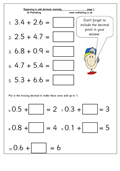 At first glance you might reach for a pencil to do a sum such as 2.5 + 4.7. However, the Primary Framework for Maths suggests that children should be competent in adding two 2-digit numbers in their heads, and there is no reason why, with a little practice this can’t include adding two decimals. The most common approach is almost identical to adding tens and units.
At first glance you might reach for a pencil to do a sum such as 2.5 + 4.7. However, the Primary Framework for Maths suggests that children should be competent in adding two 2-digit numbers in their heads, and there is no reason why, with a little practice this can’t include adding two decimals. The most common approach is almost identical to adding tens and units.
Start by adding the largest digits, in this case the units: 2 + 4 = 6.
Then add the larger of the two tenths digits, which is 0.7, making 6.7.
Finally add on the 0.5, by counting on if necessary, making 7.2. Easy!
There are, of course other approaches, such as adding 2 to the 4.7 to make 6.7, then adding the 0.5, which are equally good. It often depends on the numbers involved and any method which is quick and accurate is fine!
Maths Worksheet: Year 4 Count on Whole Tens
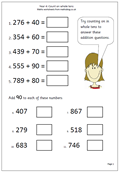 This worksheet looks at counting on in whole tens from 3-digit numbers, probably most suited for Year 4 children. There are a number of different strategies that children use to do this type of question. Some will count on in tens (still using fingers to record the number of tens they have counted). Others will use more efficient methods, such as, adding the tens digits and then adjusting the hundreds.
This worksheet looks at counting on in whole tens from 3-digit numbers, probably most suited for Year 4 children. There are a number of different strategies that children use to do this type of question. Some will count on in tens (still using fingers to record the number of tens they have counted). Others will use more efficient methods, such as, adding the tens digits and then adjusting the hundreds.
Year 6 Maths Worksheet: Rounding decimals
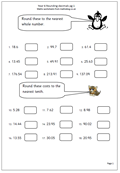 When rounding decimals to the nearest whole one the only digits that are crucial are the tenths – it does not matter what the hundredths or thousandths are.
When rounding decimals to the nearest whole one the only digits that are crucial are the tenths – it does not matter what the hundredths or thousandths are.
When rounding a number such as 3.47 to the nearest whole number the key digit to look at is the tenths digit. If it is 5 or more, round up. Less than 5, round down.
So 3.44 rounded to the nearest whole one is 3.
3.47 rounded to the nearest whole one is 4.
Data handling for year 4: Bar charts
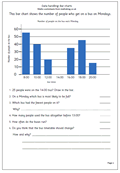 It is a while since I have posted anything on data handling so here is a page on interpreting bar charts, which also uses the 24 hour clock. it is important to point out that charts such as these must have a proper title and that the axes must be labelled. When children produce their own bar charts they often forget to do this labelling.
It is a while since I have posted anything on data handling so here is a page on interpreting bar charts, which also uses the 24 hour clock. it is important to point out that charts such as these must have a proper title and that the axes must be labelled. When children produce their own bar charts they often forget to do this labelling.
When looking at a bar chart one of the first things to do is work out how the numbers are being represented. In this case the number of people on the bus is shown in blocks of 10 and half way between would be a block of 5.
Coming soon: adding decimals, rounding and counting on in whole hundreds
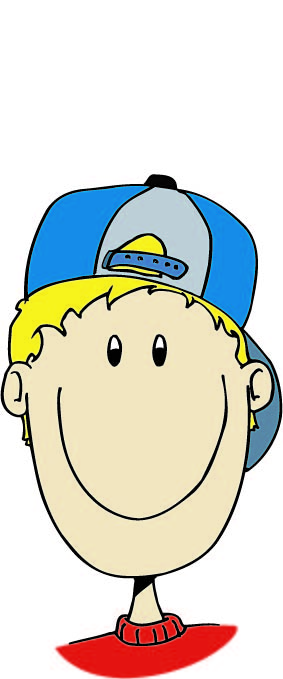 Another week goes by and the summer term in the UK will soon be over. Meanwhile why not put a few minutes aside next week to dip into our latest worksheets. They will include pages on adding decimals mentally, and for year 6 a tricky page on rounding decimals. There is also a page coming up for year 4 on counting on in whole hundreds.
Another week goes by and the summer term in the UK will soon be over. Meanwhile why not put a few minutes aside next week to dip into our latest worksheets. They will include pages on adding decimals mentally, and for year 6 a tricky page on rounding decimals. There is also a page coming up for year 4 on counting on in whole hundreds.